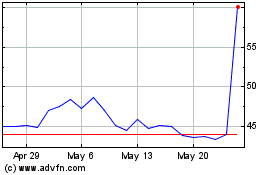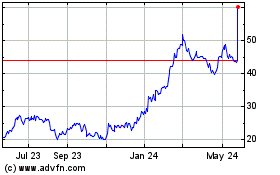Merus N.V. (Nasdaq: MRUS), a clinical-stage oncology company
developing innovative, full-length multispecific antibodies and
antibody drug conjugates (Biclonics®, Triclonics® and ADClonics®),
for cancer, today announced that the U.S. Food and Drug
Administration (FDA) has granted Breakthrough Therapy designation
(BTD) to petosemtamab in combination with pembrolizumab for the
first-line treatment of adult patients with recurrent or metastatic
programmed death-ligand 1 (PD-L1) positive head and neck squamous
cell carcinoma (r/m HNSCC) with combined positive score (CPS) ≥ 1.
This second BTD designation follows the initial receipt of BTD
and Fast Track designation for petosemtamab for the treatment of
patients with r/m HNSCC whose disease has progressed following
treatment with platinum-based chemotherapy and an anti-programmed
cell death protein 1 (anti-PD-1) antibody announced in May 2024 and
August 2023, respectively.
BTD is supported by updated data from the ongoing phase 1/2
open-label, multicenter trial evaluating petosemtamab in
combination with pembrolizumab in 1L HNSCC expressing PD-L1 (CPS≥1)
(NCT03526835). Data for this cohort was initially presented at the
American Society of Clinical Oncology® (ASCO®) Annual Meeting 2024,
which demonstrated a 67% response rate among 24 evaluable patients.
The oral presentation was detailed in our press release, Merus’
Petosemtamab in Combination with Pembrolizumab Interim Data
Demonstrates Robust Response Rate and Favorable Safety Profile in
1L r/m HNSCC (May 28, 2024). In the BTD application, Merus provided
updated interim clinical data on efficacy, durability and safety of
the cohort of petosemtamab with pembrolizumab in 1L PD-L1+ r/m
HNSCC.
“We believe petosemtamab’s second BTD continues to validate its
potential to become a new standard of care for patients with r/m
HNSCC and underscores our commitment to accelerate development of
petosemtamab for these patients,” said Fabian Zohren, M.D., Ph.D.,
Chief Medical Officer of Merus. “Importantly, this designation
indicates the interim clinical data we shared with the FDA
demonstrates petosemtamab’s potential for substantial improvement
over available therapies in the 1L PD-L1+ setting.”
BTD is intended to expedite the development and review of a
medicine to treat a serious or life-threatening condition, where
preliminary clinical evidence indicates that the drug may
demonstrate substantial improvement on clinically significant
endpoints over available therapies. BTD allows for more intensive
FDA guidance on an efficient drug development program, an
organizational commitment involving senior managers, and
experienced review staff, as appropriate, in a collaborative,
cross-disciplinary review, and eligibility for rolling review and
priority review. With this BTD, Merus plans to engage in these
discussions with the FDA in an expedited manner as we move toward
our goal of a potential Biologics License Application (BLA)
submission.
About LiGeR-HN1LiGeR-HN1, a phase 3 trial, will
evaluate the safety and efficacy of petosemtamab in combination
with pembrolizumab, compared to pembrolizumab in 1L PD-L1+ r/m
HNSCC patients. The trial is open to adult patients eligible to
receive pembrolizumab as 1L monotherapy with tumors expressing
PD-L1, CPS ≥1. The primary endpoints are overall response rate as
assessed by BICR based on RECIST v1.1 and overall survival.
Secondary endpoints are duration of response and progression free
survival. Merus plans to enroll approximately 500 patients in the
trial.
About LiGeR-HN2LiGeR-HN2, a phase 3 trial, will
evaluate the safety and efficacy of petosemtamab compared to
investigator’s choice of methotrexate, docetaxel, or cetuximab in
2/3L r/m HNSCC patients. The trial is open to adult patients that
have progressed on or after anti-PD-1 therapy and
platinum-containing therapy. The primary endpoints are overall
response rate as assessed by BICR based on RECIST v1.1 and overall
survival. Secondary endpoints are duration of response and
progression free survival. Merus plans to enroll approximately 500
patients in the trial.
About Head and Neck CancerHead and neck
squamous cell carcinoma (HNSCC) describes a group of cancers that
develop in the squamous cells that line the mucosal surfaces of the
mouth, throat, and larynx. These cancers begin when healthy cells
change and grow in an unchecked manner, ultimately forming tumors.
HNSCC is generally associated with tobacco consumption, alcohol use
and/or HPV infections, depending on where they develop
geographically. HNSCC is the sixth most common cancer worldwide and
it is estimated that there were more than 930,000 new cases and
over 465,000 deaths from HNSCC globally in 2020.1 The incidence of
HNSCC continues to rise and is anticipated to increase by 30% to
more than 1 million new cases annually by 2030.2 HNSCC is a serious
and life-threatening disease with poor prognosis despite currently
available standard of care therapies.
1 Sung et al. CA Cancer J Clin, 71:209-49, 2021; 2 Johnson,
D.E., Burtness, B., Leemans, C.R. et al. Head and neck squamous
cell carcinoma. Nat Rev Dis Primers 6(1):92, 2020
About PetosemtamabPetosemtamab, or MCLA-158, is
a Biclonics® low-fucose human full-length IgG1 antibody targeting
the epidermal growth factor receptor (EGFR) and the leucine-rich
repeat containing G-protein-coupled receptor 5 (LGR5). Petosemtamab
is designed to exhibit three independent mechanisms of action
including inhibition of EGFR-dependent signaling, LGR5 binding
leading to EGFR internalization and degradation in cancer cells,
and enhanced antibody-dependent cell-mediated cytotoxicity (ADCC)
and antibody-dependent cellular phagocytosis (ADCP) activity.
About Merus N.V.Merus is a clinical-stage
oncology company developing innovative full-length human bispecific
and trispecific antibody therapeutics, referred to as
Multiclonics®. Multiclonics® are manufactured using industry
standard processes and have been observed in preclinical and
clinical studies to have several of the same features of
conventional human monoclonal antibodies, such as long half-life
and low immunogenicity. For additional information, please visit
Merus’ website, Twitter and LinkedIn.
Forward-Looking Statements
This press release contains forward-looking statements within
the meaning of the Private Securities Litigation Reform Act of
1995. All statements contained in this press release that do not
relate to matters of historical fact should be considered
forward-looking statements, including without limitation, the
potential benefits of BTD for petosemtamab’s development for the
first-line treatment of adult patients with recurrent or metastatic
programmed death-ligand 1 (PD-L1) positive head and neck squamous
cell carcinoma (R/M HNSCC) with CPS ≥ 1 ; Merus’ belief that
petosemtamab’s second BTD continues to validate its potential to
become a new standard of care for patients with r/m HNSCC; Merus’
commitment to accelerate development of petosemtamab for these
patients; Merus’ belief that this designation indicates the interim
clinical data shared with the FDA demonstrates petosemtamab’s
potential for substantial improvement over available therapies in
the 1L PD-L1+ setting; the potential for BTD to expedite the
development and review of a medicine to treat a serious or
life-threatening condition, where preliminary clinical evidence
indicates that the drug may demonstrate substantial improvement on
clinically significant endpoints over available therapies; the
potential of BTD to allow for more intensive FDA guidance on an
efficient drug development program, an organizational commitment
involving senior managers, and experienced review staff, as
appropriate, in a collaborative, cross-disciplinary review, and
eligibility for rolling review and priority review; and Merus’
plans to engage in these discussions with the FDA in an expedited
manner as we move toward our goal of a potential Biologics License
Application (BLA) submission. These forward-looking statements are
based on management’s current expectations. These statements are
neither promises nor guarantees, but involve known and unknown
risks, uncertainties and other important factors that may cause our
actual results, performance or achievements to be materially
different from any future results, performance or achievements
expressed or implied by the forward-looking statements, including,
but not limited to, the following: our need for additional funding,
which may not be available and which may require us to restrict our
operations or require us to relinquish rights to our technologies
or antibody candidates; potential delays in regulatory approval,
which would impact our ability to commercialize our product
candidates and affect our ability to generate revenue; the lengthy
and expensive process of clinical drug development, which has an
uncertain outcome; the unpredictable nature of our early stage
development efforts for marketable drugs; potential delays in
enrollment of patients, which could affect the receipt of necessary
regulatory approvals; our reliance on third parties to conduct our
clinical trials and the potential for those third parties to not
perform satisfactorily; impacts of the volatility in the global
economy, including global instability, including the ongoing
conflicts in Europe and the Middle East; we may not identify
suitable Biclonics® or bispecific antibody candidates under our
collaborations or our collaborators may fail to perform adequately
under our collaborations; our reliance on third parties to
manufacture our product candidates, which may delay, prevent or
impair our development and commercialization efforts; protection of
our proprietary technology; our patents may be found invalid,
unenforceable, circumvented by competitors and our patent
applications may be found not to comply with the rules and
regulations of patentability; we may fail to prevail in potential
lawsuits for infringement of third-party intellectual property; and
our registered or unregistered trademarks or trade names may be
challenged, infringed, circumvented or declared generic or
determined to be infringing on other marks. These and other
important factors discussed under the caption “Risk Factors” in our
Quarterly Report on Form 10-Q for the period ended September 30,
2024, filed with the Securities and Exchange Commission, or SEC, on
October 31, 2024, and our other reports filed with the SEC, could
cause actual results to differ materially from those indicated by
the forward-looking statements made in this press release. Any such
forward-looking statements represent management’s estimates as of
the date of this press release. While we may elect to update such
forward-looking statements at some point in the future, we disclaim
any obligation to do so, even if subsequent events cause our views
to change, except as required under applicable law. These
forward-looking statements should not be relied upon as
representing our views as of any date subsequent to the date of
this press release. Multiclonics®, Biclonics®, Triclonics® and
ADClonics® are registered trademarks of Merus N.V.
Investor and Media Inquiries:
Sherri Spear
Merus N.V.
SVP Investor Relations and Strategic Communications
617-821-3246
s.spear@merus.nl
Kathleen Farren
Merus N.V.
Assoc. Director IR/Corp Comms
617-230-4165
k.farren@merus.nl
Merus NV (NASDAQ:MRUS)
Historical Stock Chart
From Jan 2025 to Feb 2025

Merus NV (NASDAQ:MRUS)
Historical Stock Chart
From Feb 2024 to Feb 2025
